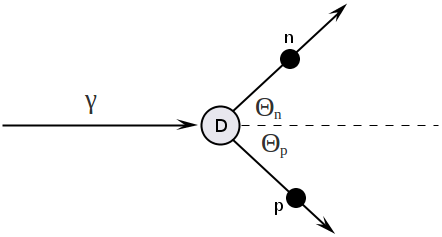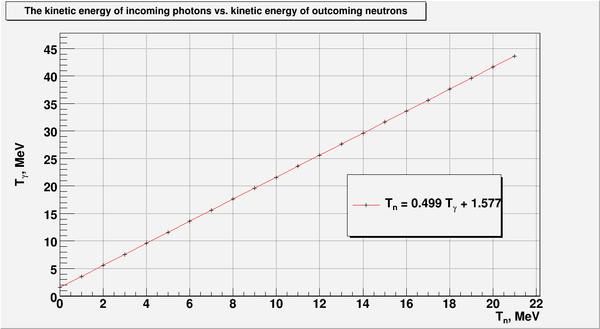Difference between revisions of "Neutron Polarimeter"
| Line 60: | Line 60: | ||
2) from formula [1] above we can predict the incident photon energy based on the detected neutron energy (neutron polarimeter). | 2) from formula [1] above we can predict the incident photon energy based on the detected neutron energy (neutron polarimeter). | ||
| + | |||
| + | [[File:Tgamma01.png | 600 px]] | ||
3) from formula [2] above we can predict the detected neutron energy based on the incident photon energy. | 3) from formula [2] above we can predict the detected neutron energy based on the incident photon energy. | ||
Revision as of 19:34, 5 April 2011
Four-vector Algebra
Consider the two bode reaction :
Write down all four-vectors:
Now apply the conservation of four-momentum:
Squaring both side of equation above and using the four-momentum invariants we have:
Detector located at case
Detector is located at , and the formula above is simplified:
We can easily solve the equation above with respect to incident photon energy:
For non-relativistic neutrons and the formula above is become:
Substituting the corresponding masses, we get finally:
and visa versa:
Here I derived the formula [2] just inversing the formula [1]. I can as well start from exact solution above, solve this equation with respect to neutron energy, do the non-relativistic approximation and get exactly the same formula [2]. But anyway we ended up with two useful non-relativistic formulas we can analyze now:
1) from formula [1] above we can predict the threshold of reaction:
2) from formula [1] above we can predict the incident photon energy based on the detected neutron energy (neutron polarimeter).
3) from formula [2] above we can predict the detected neutron energy based on the incident photon energy.
- for the incident photons up to we can detect neutrons up to
- for the incident photons up to we can detect neutrons up to
4) we can do the error calculations.
Example of error calculation (need to be updated to the formulas [1] and [2] above)
example 1
Say, we have, 10 MeV neutron with uncertainty 1 MeV, the corresponding uncertainly for photons energy is:
example 2
Say, the neutron's time of flight uncertainly is 1 ns
The neutron's kinetic energy is:
And:
Also we need the neutron's time of flight as function of neutron's kinetic energy:
Say, we have 10 MeV neutron, 1 m away detector, and neutron's time of flight uncertainty is 1 ns. Then the neutron time of flight is:
Neutron kinetic energy errors are:
And photon energy errors are:
Below are some examples for different detector distance and neutron kinetic energy:
| 1 ns | 1 m | 5 MeV | 0.103 | 32 ns | 0.31 MeV | 6.2 % | 0.64 MeV | 5.3 % |
| 1 ns | 1 m | 10 MeV | 0.145 | 23 ns | 0.88 MeV | 8.8 % | 1.81 MeV | 8.1 % |
| 1 ns | 1 m | 20 MeV | 0.203 | 16 ns | 2.51 MeV | 12.6 % | 5.16 MeV | 12.1 % |
| 1 ns | 1 m | 0.5 MeV | 0.033 | 102 ns | 0.010 MeV | 1.9 % | ||
| 1 ns | 1 m | 1 MeV | 0.046 | 72 ns | 0.028 MeV | 2.8 % | ||
| 1 ns | 1 m | 2 MeV | 0.065 | 51 ns | 0.078 MeV | 3.9 % | ||
| 1 ns | 1 m | 4 MeV | 0.092 | 36 ns | 0.22 MeV | 5.5 % |

